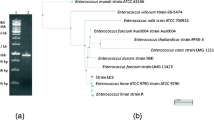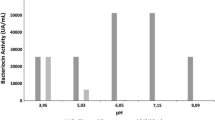Abstract
Lactobacillus plantarum JJ18 and Lactobacillus plantarum subsp. plantarum JJ60, probiotics from idli batter, produce bacteriocins JJ18 and JJ60 having a wide spectrum of activity. After optimising the environmental conditions for bacteriocin production the effect of various media components was determined. Maximum bacteriocin production was observed in MRS broth, pH 6.4 at 37 °C after 36 h. Tryptone (as nitrogen source) and glucose (as carbon source) are required for optimal production of bacteriocins JJ18 and JJ60. Activity was not affected by surfactants like Triton X-100, Tween 80 and Tween 20 or by treatment with NaCl, urea and EDTA. Protease treatment resulted in complete loss of activity of the partially purified bacteriocins JJ18 and JJ60, while lipase and α-amylase had no effect, indicating that the bacteriocin is a simple protein. Tris tricine SDS-PAGE electrophoresis depicted a single band of less than 3.5 kDa. However, the strain Lactobacillus plantarum JJ18 was inhibited by bacteriocin JJ60 and Lactobacillus plantarum JJ60 by bacteriocin JJ18, whereas no inhibition was observed against the respective producer strains, indicating that the two bacteriocins are different. The bacteriocins remained active over a wide range of pH and temperature. The bacteriocins were able to adsorb onto producer and target cells, Lactobacillus plantarum and Listeria monocytogenes and differentially in the presence of various surfactants, salts and solvents. A bactericidal mode of action was observed against Listeria monocytogenes. Given their wide spectrum of activity against various pathogens, the bacteriocins JJ18 and JJ60 can be applied as bio-preservatives in the food industry.




Similar content being viewed by others

References
Aasen IM, Moreto T, Katla T, Axelsson L, Storro I (2000) Influence of complex nutrients, temperature and pH on bacteriocin production by Lactobacillus sakei CCUG 42687. Appl Microbiol Biotechnol 53:159–166
Agaliya PJ, Jeevaratnam K (2012) Screening of Lactobacillus plantarum isolated from fermented idli batter for probiotic properties. Afr J Biotechnol 11:12856–12864
Agrawal R, Rati ER, Vijayendra SVN, Varadaraj MC, Prasad MS, Nand K (2000) Flavour profile of idli batter prepared from defined microbial starter cultures. World J Microbiol Biotechnol 16:687–690
Atrih A, Rekhif N, Moir AJG, Lebrihi A, Lefebvre G (2001) Mode of action, purification and amino acid sequence of plantaricin C19, an anti-Listeria bacteriocin produced by Lactobacillus plantarum C19. Int J Food Microbiol 68:93–104
Aymerich MT, Garriga M, Monfort JM, Nes I, Hugas M (2000) Bacteriocin-producing lactobacilli in Spanish style fermented sausages: characterization of bacteriocins. Food Microbiol 17:33–45
Bauer R, Dicks LMT (2005) Mode of action of lipid II-targeting lantibiotics. Int J Food Microbiol 101:201–216
Caplice E, Fitzgerald GF (1999) Food fermentations: role of microorganisms in food production and preservation. Int J Food Microbiol 50:131–149
Cintas LM, Casaus MP, Herranz C, Nes IF, Hernandez PE (2001) Review: bacteriocins of lactic acid bacteria. Food Sci Technol Int 7:4281–4305
Cleveland J, Montville TJ, Nes IF, Chikindas ML (2001) Bacteriocins: safe, natural antimicrobials for food preservation. Int J Food Microbiol 71:1–20
da Silva MP, Daroit DJ, Brandelli A (2010) Food applications of liposome-encapsulated antimicrobial peptides. Trends Food Sci Technol 21:284–292
El-Ghaisha S, Ahmadovaa A, Hadji-Sfaxia I, El Mecherfia KE, Bazukyane I, Choiseta Y, Rabesona H, Sitohy M, Popov YG, Kuliev AA, Mozzi FM, Cobert JM, Haertle T (2011) Potential use of lactic acid bacteria for reduction of allergenicity and for longer conservation of fermented foods. Trends Food Sci Technol 22:509–516
Enan G, El-Essawyb AA, Uyttendaele M, Debeverea J (1996) Antibacterial activity of Lactobacillus plantarum UGl isolated from dry sausage: characterization, production and bactericidal action of plantaricin UG 1. Int J Food Microbiol 30:189–215
Gong HS, Meng XC, Wang H (2010) Plantaricin MG active against Gram-negative bacteria produced by Lactobacillus plantarum KLDS1.0391 isolated from “Jiaoke”, a traditional fermented cream from China. Food Control 21:89–96
Gornall AG, Bardwill GJ, David MM (1949) Determination of serum proteins by means of biuret reaction. J Biol Chem 117:751–766
Henderson JR, Chopko AL, van Wassenaar D (1992) Purification and primary structure of pediocin PA-1 produced by Peciococcus acidilactici PAC-1.0. Arch Biochem Biophys 295:5–12
Heu S, Oh J, Kang Y, Ryu S, Cho SK, Cho Y, Cho M (2001) Gly gene cloning and expression and purification of Glycinecin A, a bacteriocin produced by Xanthomonas campestris pv. Glycines 8ra. Appl Environ Microbiol 67:4105–4110
Jamuna M, Jeevaratnam K (2004) Isolation and characterisation of lactobacilli from some traditional fermented foods and evaluation of the bacteriocins. J Gen Appl Microbiol 50:79–90
Jamuna M, Babusha ST, Jeevaratnam K (2005) Inhibitory efficacy of nisin and bacteriocins from Lactobacillus isolates against food spoilage and pathogenic organisms in model and food systems. Food Microbiol 22:449–454
Klaenhammer TR (1988) Bacteriocins of lactic acid bacteria. Biochimie 70:337–349
Leal-Sánchez MV, Jiménez-Díaz R, Maldonado-Barragán A, Garrido-Fernández A, Ruiz-Barba JL (2002) Optimization of bacteriocin production by batch fermentation of Lactobacillus plantarum LPCO10. Appl Environ Microbiol 68:4465–4471
Marco ML, Pavan S, Kleerebezem M (2006) Towards understanding molecular modes of probiotic action. Curr Opin Biotechnol 17:204–210
Morisset D, Berjeaud JM, Marion D, Lacombe C, Frère J (2004) Mutational analysis of mesentericin Y105, an anti-Listeria bacteriocin, for determination of impact on bactericidal activity, in vitro secondary structure, and membrane interaction. Appl Environ Microbiol 70:4672–4680
Nes I, Johnsborg O (2004) Exploration of antimicrobial potential in LAB by genomics. Curr Opin Biotechnol 15:1–5
Parente E, Ricciardi A (1994) Influence of pH on the production of enterocin 1146 during batch fermentation. Lett Appl Microbiol 9:12–15
Powell JE, Witthuhn RC, Todorov SD, Dicks LMT (2007) Characterization of bacteriocin ST8KF produced by a kefir isolate Lactobacillus plantarum ST8KF. Int Dairy J 17:190–198
Schägger H, Von Jagow G (1987) Tricine-sodium dodecyl sulphate polyacrylamide gel electrophoresis for the separation of proteins in the range from 1 to 100 kDa. Anal Biochem 166:368–379
Todorov SD (2008) Bacteriocin production by Lactobacillus plantarum AMA-K isolated from Amasi, a Zimbabwean fermented milk product and study of adsorption of bacteriocin AMA-K to Listeria spp. Braz J Microbiol 38:178–187
Todorov SD, Dicks LMT (2005a) Effect of growth medium on bacteriocin production by Lactobacillus plantarum ST194BZ, a strain isolated from boza. Food Technol Biotechnol 43:165–173
Todorov SD, Dicks LMT (2005b) Pediocin ST18, an anti-listerial bacteriocin produced by Pediococcus pentosaceus ST18 isolated from boza, a traditional cereal beverage from Bulgaria. Process Biochem 40:365–370
Todorov SD, Dicks LMT (2006a) Effect of medium components on bacteriocin production by Lactobacillus plantarum strains ST23LD and ST341LD, isolated from spoiled olive brine. Microbiol Res 161:102–108
Todorov SD, Dicks LMT (2006b) Parameters affecting the adsorption of plantaricin 423, a bacteriocin produced by Lactobacillus plantarum 423 isolated from sorghum beer. Biotechnol J 1:405–409
Todorov SD, Nyati H, Meincken M, Dicks LMT (2007a) Partial characterization of bacteriocin AMA-K, produced by Lactobacillus plantarum AMA-K isolated from naturally fermented milk from Zimbabwe. Food Control 18:656–664
Todorov SD, Powell JE, Mencken M, Witthuhn RC, Dicks LMT (2007b) Factors affecting the adsorption of Lactobacillus plantarum bacteriocin bacST8KF to Enterococcus faecalis and Listeria innocua. Int J Dairy Technol 60:221–227
Todorov SD, Ho P, Vaz-Velho M, Dicks LMT (2010) Characterization of bacteriocins produced by two strains of Lactobacillus plantarum isolated from Beloura and Chouriço, traditional pork products from Portugal. Meat Sci 84:334–343
Todorov SD, Furtado DN, Saad SMI, Tome E, Franco BDGM (2011a) Potential beneficial properties of bacteriocin-producing lactic acid bacteria isolated from smoked salmon. J Appl Microbiol 110:971–986
Todorov SD, Prévost H, Lebois M, Dousset X, LeBlanc JG, Franco BDGM (2011b) Bacteriocinogenic Lactobacillus plantarum ST16Pa isolated from papaya (Carica papaya)—from isolation to application: characterization of a bacteriocin. Food Res Int 44:1351–1363
Tomé E, Teixeira P, Gibbs PA (2006) Anti-listerial inhibitory lactic acid bacteria isolated from commercial cold smoked salmon. Food Microbiol 23:399–405
Xie Y, An H, Hao Y, Qin Q, Huang Y, Luo Y, Zhang L (2011) Characterization of an anti-Listeria bacteriocin produced by Lactobacillus plantarum LB-B1 isolated from koumiss, a traditionally fermented dairy product from China. Food Control 22:1027–1031
Yang R, Johnson MC, Ray B (1992) Novel method to extract large amounts of bacteriocins from lactic acid bacteria. Appl Environ Microbiol 58:3355–3359
Yildirim Z, Avşar YK, Yildirim M (2002) Factors affecting the adsorption of buchnericin LB, a bacteriocin produced by Lactobacillus buchneri. Microbiol Res 157:103–107
Acknowledgement
P.J.A., Junior Research Fellow, thanks the Indian Council of Medical Research, New Delhi for financial support in the form of fellowship.
Author information
Authors and Affiliations
Corresponding author
Rights and permissions
About this article
Cite this article
Agaliya, P.J., Jeevaratnam, K. Characterisation of the bacteriocins produced by two probiotic Lactobacillus isolates from idli batter. Ann Microbiol 63, 1525–1535 (2013). https://doi.org/10.1007/s13213-013-0616-y
Received:
Accepted:
Published:
Issue Date:
DOI: https://doi.org/10.1007/s13213-013-0616-y



